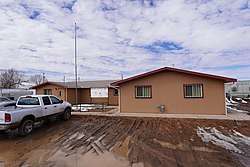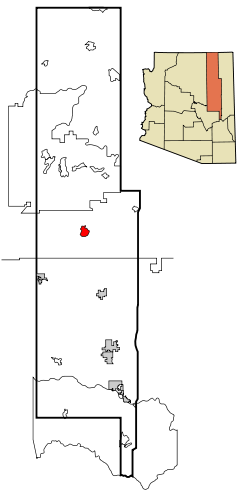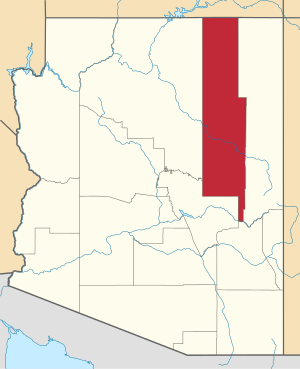Dilkon, Arizona
Dilkon (Navajo: Tsézhin Dilkǫǫh) is a census-designated place (CDP) in Navajo County, Arizona, United States. The population was 1,184 at the 2010 census. The name of the town is said to be derived from the Navajo phrase "Smooth black rock" or "Bare surface.”[3]
Dilkon, Arizona | |
|---|---|
 Dilkon Chapter Admin building | |
 Location in Navajo County and the state of Arizona | |
 Dilkon, Arizona Location in the United States | |
| Coordinates: 35°21′52″N 110°19′13″W | |
| Country | United States |
| State | Arizona |
| County | Navajo |
| Area | |
| • Total | 16.60 sq mi (43.00 km2) |
| • Land | 16.60 sq mi (43.00 km2) |
| • Water | 0.00 sq mi (0.00 km2) |
| Elevation | 5,885 ft (1,794 m) |
| Population (2010) | |
| • Total | 1,184 |
| • Estimate (2016)[2] | N/A |
| Time zone | UTC-7 (MST) |
| • Summer (DST) | UTC-6 (MDT) |
| ZIP code | 86047 |
| Area code(s) | 928 |
| FIPS code | 04-19280 |
| GNIS feature ID | 0024399 |
Government
Dilkon Chapter is one of 110 certified chapters of the Navajo Nation local. As of December 21, 2010, the chapter has achieved Local Governance Certification. Council delegates: Jerry Freddie (four terms), Elmer Begay (2 terms) Chapter president: Lorenzo lee Sr. Chapter vice president: Chapter secretary: Chapter treasure:
Past Council delegates:
Manual Shirley 1978-1990
Alfred Joe 1990-1994
Elmer Clark 1990-1994
Geography
Dilkon is located at 35°21′38″N 110°18′56″W (35.3606096, -110.3155400).[4] It is located on the Colorado Plateau and within the area of the Hopi Buttes volcanic field.
According to the United States Census Bureau, the CDP has a total area of 16.8 square miles (44 km2), all of it land.
Demographics
| Historical population | |||
|---|---|---|---|
| Census | Pop. | %± | |
| 2000 | 1,265 | — | |
| 2010 | 1,184 | −6.4% | |
| U.S. Decennial Census[5] | |||
| Languages (2000) [6] | Percent |
|---|---|
| Spoke Navajo at home | 71.34% |
| Spoke English at home | 28.66% |
As of the census[7] of 2000, there were 1,265 people, 298 households, and 264 families residing in the CDP. The population density was 75.4 people per square mile (29.1/km2). There were 379 housing units at an average density of 22.6/sq mi (8.7/km2). The racial makeup of the CDP was 97.00% Native American, 1.58% White, 0% Asian, Pacific Islander, or Black/African American, 0.40% from other races, and 1.03% from two or more races. 1.82% of the population were Hispanic or Latino of any race.
There were 298 households, out of which 61.4% had children under the age of 18 living with them, 50.0% were married couples living together, 31.2% had a female householder with no husband present, and 11.1% were non-families. 10.1% of all households were made up of individuals, and 2.0% had someone living alone who was 65 years of age or older. The average household size was 4.24 and the average family size was 4.50.
In the CDP, the population was spread out, with 46.8% under the age of 18, 10.6% from 18 to 24, 23.8% from 25 to 44, 14.3% from 45 to 64, and 4.5% who were 65 years of age or older. The median age was 19 years. For every 100 females, there were 89.4 males. For every 100 females age 18 and over, there were 84.4 males.
The median income for a household in the CDP was $16,146, and the median income for a family was $14,966. Males had a median income of $16,786 versus $18,846 for females. The per capita income for the CDP was $5,949. About 56.1% of families and 59.1% of the population were below the poverty line, including 65.8% of those under age 18 and 76.5% of those age 65 or over.
Education
The area is served by the Holbrook Unified School District. Nearby Indian Wells Elementary School serves Dilkon.
Environmental movement
In 1988, Waste-Tech Services, Inc. approached and was approved by the tribal government of Dilkon, Arizona to build a $40 million recycling plant. It was hoped this project could bring 200 jobs to Dilkon; an area with 75% unemployment at this point. Further research revealed to the community that the recycling plant would instead be a toxic waste dump where waste was trucked in from California, Nevada, and Colorado to be burned in Dilkon. Public outrage built when it was discovered that medical human waste, including amputated limbs, would also be burned at this location. The Navajo believe that the dead are to be respected and this process appeared to them extremely disrespectful.[8] To combat the possibility of a Waste-Tech Services, Inc. facility, the citizens created the organization Citizens Against Ruining Our Environment (CARE). Co-founded by Lori Goodman and Abe Plummer, CARE was able to reduce the project’s credibility in Dilkon. On February 25, 1989, Waste-Tech Services, Inc. and its partner company High-Tech Recycling, Inc. put on a public hearing and brought in a panel of engineers to discuss the project, in hopes of gaining back public favor. The final citizen’s vote was ninety-nine opposed to the project, six for the project. On March 6, tribal leaders unanimously rescinded their approval of the project. CARE had successfully blocked the possibility of a toxic waste dump on their land.[9] Shortly after this success other Navajo grassroots environmental groups began to form to fight the overwhelming environmental racism stacked against them. Due to the lower lack of wealth and education on American Indian reservations, and their status as a minority, the U.S. government has allowed the encroachment of mining and energy companies for over 40 years to develop the Diné lands, creating environmental and health devastation and loss of aquifer water resources. CARE found that its success could benefit the other struggling organizations, so they banded together into a conglomerate environmental group representing all of the Navajo people, called Diné CARE. (Diné simply means "The People" and it is what the Navajo call themselves.)[10]
Indigenous Environmental Network
Diné CARE had also helped to host the first Indigenous Environmental Network (IEN), a combination of a large network of environmental movements and organizations of indigenous people in the United States, as well as an annual conference that brings together members of the IEN. The IEN have 6 main goals:
- Educate and empower indigenous grassroots people to address and develop strategies for the protection of our environment;
- Reaffirm our traditional and natural laws as Indigenous peoples;
- Recognize, support, promote, environmentally sound lifestyles and economic livelihoods;
- Commit to influence all politics that affect our people on a local, regional, national and international level;
- Include youth and elders in all levels of activities;
- Protect our rights to practice our spiritual beliefs.[9]
The IEN also has an Environmental Code of Ethics which was written in Bear Butte, South Dakota in 1991. This code further helps to clarify their stance as an indigenous and environmental alliance. One of the key problems that IEN addresses in its Environmental Code of Ethics is that indigenous people culturally and Native Americans politically, are tied to their land. Native Americans in the United States and Canada are restricted to reservations if they want to maintain any kind of political nation idea. Similarly, indigenous people often have religious or ancestral ties to specific tracts of land. This unique relationship makes them less likely to leave, makes the land more valuable, and makes them even more staunchly opposed to polluting it in any way. Each year the conference is held in a different indigenous Nation.[11] Some example of locations and how the network has already made large gains in the fight for indigenous environmental equality;
- The 1992 conference was held in Celilo Falls, Oregon - "formerly a major salmon-fishing site until dams were constructed on the Columbia River, downstream from the Hanford Nuclear Reservation."
- The 1993 conference was held at Sac and Fox Reservation, Oklahoma, where it helped to defeat a proposed nuclear waste site.
- The 1994 conference was held on Mole Lake Reservation, Wisconsin, where Exxon plans to open a huge zinc - copper mine upstream from the Mole Lake Chippewa's wild rice beds.
- The 12th Protecting Mother Earth Gathering in Penticton, British Columbia, Canada, August 2001, was the first held in Canada.
- The June 2004 conference was held near the sacred Bear Butte, South Dakota, again.[12]
The IEN has also branched out to international influences. In 2009, they began their Red Road to Copenhagen initiative. Delegates from all of their member organizations attended the 15th Session of the Conference of the Parties (COP15) of the United Nations Framework Convention on Climate Change (UNFCCC) in Copenhagen, Denmark, December 7–18, 2009. Their statement proclaims that “this initiative will bring accumulated traditional knowledge of Indigenous peoples from North America coming from climate-energy impact zones and persons experienced in linking an indigenous rights-based framework to climate policy.”[13]
IEN claims its success lies in the bridging of tribal and age barriers. Not only does it emphasize the interaction of its varying member tribes, but also through specific youth and elders groups. IEN is governed party by an Elders Council. Their Youth Council solicits involvement by young indigenous peoples and tries to make connections between urban culture of the youth and the environmental issues the communities face.[9]
Media
The environmental movement in Dilkon, Arizona was featured in the People of Color Environmental Leadership Conference Resource Tape. The tape was created by the United Church of Christ Commission for Racial Justice. 15 minutes long, the tape features five different communities of color and their struggle with environmental injustices.
- Cancer Alley, LA: Approximately 25% of the nations chemical industry and an alarmingly high cancer rate is located on the 150 mile stretch.
- Reveilletown, LA: A century old African-American community boarded and leveled in 1988 due to chemical poisoning of its residents.
- Altgeld Gardens, IL (Chicago): African-American community surrounded on three sides by waste disposal facilities, a landfill, hazardous waste incinerator, and sewage treatment.
- McFarland, CA: Predominantly Mexican farming community with high cancer rate and land and water contaminated by pesticide spraying.
- Dilkon, AZ: Native American community that challenged and defeated a company claiming to want to build a recycling plant but actually wanting to build a toxic waste dump.[14]
References
- "2016 U.S. Gazetteer Files". United States Census Bureau. Retrieved Jul 18, 2017.
- "Population and Housing Unit Estimates". Retrieved June 9, 2017.
- "Profile for Dilkon, Arizona". Podunk: The Power of Place. Retrieved 2010-04-26.
- U.S. Geological Survey Geographic Names Information System: Dilkon, Arizona
- "Census of Population and Housing". Census.gov. Retrieved June 4, 2016.
- https://apps.mla.org/cgi-shl/docstudio/docs.pl?map_data_results
- "U.S. Census website". United States Census Bureau. Retrieved 2008-01-31.
- Brook, Daniel (Jan 1998). "Environmental Genocide: Native Americans and Toxic Waste". The American Journal of Economics and Sociology. 57: 105–113. doi:10.1111/j.1536-7150.1998.tb03260.x. JSTOR 3487423.
- "The Indigenous Environmental Network". About IEN. IEN. Archived from the original on 2010-05-12. Retrieved 2010-04-26.
- "Navajo People-Dine". Retrieved 2010-04-26.
- Brook, Daniel (Jan 1998). "Environmental Genocide: Native Americans and Toxic Waste". American Journal of Economics and Sociology. 57: 105–113. doi:10.1111/j.1536-7150.1998.tb03260.x. JSTOR 3487423.
- Grossman, Zoltan (November 1995). "Linking the Native Movement for Sovereignty and the Environmental Movement". Native Americans and the Environment. Z Magazine 8(11): 42–50. Archived from the original on 2010-06-16. Retrieved 2010-04-26.
- "IEN COP15 Delegation Information". IEN. Missing or empty
|url=(help) - Lee, Charles. "People of Color Environmental Leadership Conference". Resource Tape. United Church of Christ Commission for Racial Justice. Archived from the original on 2010-04-12. Retrieved 2010-04-26.
